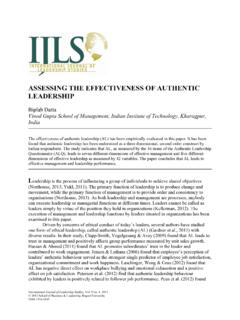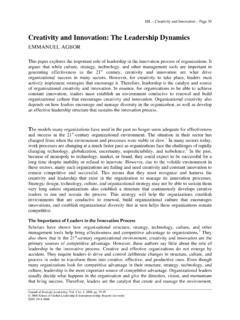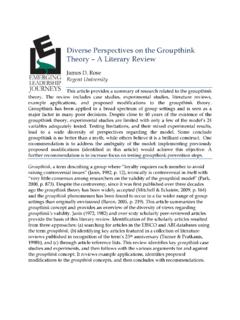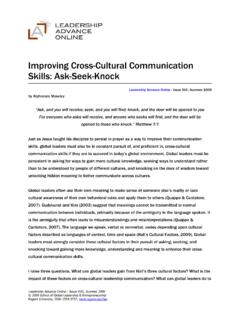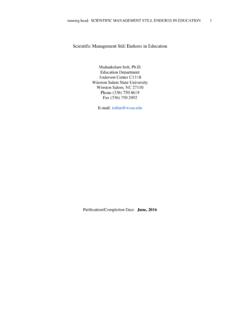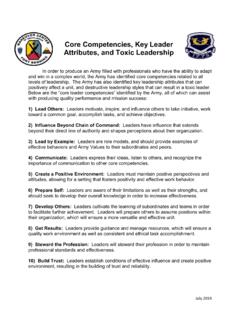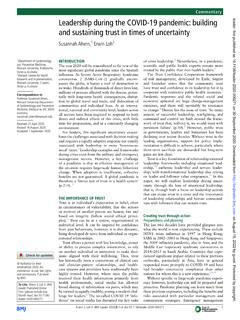Transcription of The Leader-Follower Relationship - Regent University
1 Regent University The Leader-Follower Relationship : Practitioner Observations Leadership Advance Online- Issue VI Winter 2006 by Don Grayson & Ryan Speckhart If you re not the lead dog the scenery never changes. So read the caption of a dog sled poster hanging on the wall of an executive s office in 1981. I saw this poster early on in my career as a consulting psychologist. I did not enjoy working with this executive, for I found him arrogant and too absorbed with himself, while insensitive to others. The executive made business decisions based upon personal benefits, even if it harmed other people or the company. The executive thought his title of leader entitled him to do as he pleased and, in his mind, he was very much the lead dog. As my colleague and I discussed this, we determined that If this executive were our leader, we would want him to be the lead dog, so we could watch him like a hawk.
2 In reality, very few of us are the lead dog, and for each time we are in the lead, there are several more times we play the role of follower. Larger than life leaders too often define leadership as the Lee Iacocas, Jack Welchs, Warren Buffets, Bill Gates, and Rudy Giulianis. These individuals are the exception, and very few of us possess the qualities these leaders exhibit. Even if we did, still fewer of us find ourselves in a situation where we can exercise those qualities. Yet, the experts lead us to believe that we should strive to be like these great leaders . While striving is admirable, reality can get lost. In our society, leaders are glorified and followers are denigrated with unfortunate counterproductive results. During our years as consulting psychology practitioners, we have made five distinct observations concerning the Leader-Follower Relationship .
3 Observation One: Only the leader matters right? Because leadership is greatly overvalued in society and in business, too many individuals and organizations aspire to leadership who should not. Today s society is inclined to place leadership on a pedestal. We are continually reminded of the glory of being number one and the shame of being number two. In sports, only the champion matters. It may even be worse to be the runner up than to not even be in the championship game. The Buffalo Bills of the early 1990 s were a great football team, having made it to the Super Bowl four consecutive years. However, rather than being remembered as one of the top two teams four years running, they are remembered as the losing team in four consecutive Super Bowls. The media depicts leaders as individuals who take charge and who respond quickly and aggressively in the face of crises.
4 The business community glorifies leadership, while books and training programs abound on the topic of leadership. In fact, lists over 59,000 books on the topic of leadership. According to Brown (2003) the year 1999 saw 2,000 books published in the United States alone, on the topic of leadership. A review of municipality mission statements revealed innovation (clearly a leader and not a follower) as one of 2 The Leader-Follower Relationship : Practitioner Observations: Grayson & Speckhart the most common descriptors contained within those statements. A recent Audi ad captured the glorification of leadership, most bluntly, when it stated, Never follow. As a result of this glorification of leadership, many who strive to be leaders would actually make better followers, as well as be more satisfied in the followership role. Perhaps they would be content to be followers if it were seen as a more noble position.
5 We have consulted with numerous leaders who, when honest with themselves, do not wish to be in a leadership role and long for the days when they were the individual contributor, the salesperson or the engineer. The research on leadership effectiveness is dismal. Numerous studies suggest an effectiveness rating of 25 50 percent (Hogan, Curphy, and Hogan, 1994). A study by consulting firm Development Dimensions International showed little employee confidence in their leaders . Only 38 percent of employees surveyed expressed high confidence in leadership (Workforce Management, 2003). Many factors contribute to a lack of leadership success; however, if effective following were a more acceptable career path, then fewer leaders would be miscast and thus, substantiate the Peter Principle. For everyone to try and lead or to innovate is a waste of resources. Innovation requires a significant commitment of time, energy and money.
6 Most individuals and organizations would be best served by letting others, with more capabilities and resources, lead. They then might copy, build upon, or refine the innovation to suit their own particular circumstances. Those municipalities dedicated to innovation only end up wasting scarce resources. It makes far more sense for those municipalities who have the financial resources and who can hire the best and the brightest to provide innovation for other municipalities to follow when appropriate. Observation Two: Followership development is vital. Because followership is greatly undervalued in society and in business, to the detriment of organizational performance, too little attention is placed on the development of strong and capable followers. Business trends, such as empowerment, flattening organizational structure, self-managed teams and You, Inc.
7 Suggest the need for strong and capable followers. The rapidly evolving business place is forcing us to re-examine the traditional concept of leadership, yet we are slow to catch up with today s demands. Brown (2003) states, More than ever, technology is leveling the playing field between leaders and those they lead. Thanks to the Internet, leaders are no longer the exclusive source of vital information about their companies or fields; therefore they can no longer expect to be followed blindly by their now well-informed, more-skeptical ranks. leaders in the Information Age will have to work harder than ever to earn respect and be effective ( ). Robert Reich agrees, in his book, The Future of Success, by declaring the following: All institutions are flattening into networks of entrepreneurial groups, temporary projects, electronic communities, and coalitions linked to various brands and portals.
8 In this emerging cyber-landscape, it will be odd to speak of institutional loyalty because there will be fewer clear boundaries around any institution. Organizations use to be recognizable: They were shaped like pyramids, with top executives, layers of middle-level managers and staff, and a large number of people doing relatively simple and repetitive tasks at the bottom. You were either in a member, resident, partner, or employee or on the outside. Now bureaucratic controls are no longer necessary for coordinating large numbers of people (p. 84). Yet, little effort is expended to train effective followers. For every follower training program, there are thousands of leader training programs.
9 This disparity exists despite the fact that there are significantly more followers than leaders , particularly when you consider that all leaders are also followers. Even the CEO reporting to a board of directors is a follower in his or her own right. It seems a better return on investment to increase training budgets for followers and decrease the far more generous training budgets for the relatively few leaders . In our experience, it is the follower who often contributes directly to organizational success. There s the rental car counter employee who is so pleasant and cheerful that he has developed a following. There s the municipal Leadership Advance Online 3 Published by the School of Leadership Studies, Regent University arts employee who philosophizes, It takes just 10 percent more effort to get to a yes and causes the organization to receive accolades for innovative programs.
10 There s the engineer who risks his job by speaking candidly to the firm s president about problems in the field. Through articulating the desired characteristics for successful followership; by training, coaching and mentoring for successful followership; and by rewarding successful followership, organizations will become more successful. Observation Three: What s wrong with being number two? The number two person is a legitimate role and a potential career ambition; it is not merely a stepping stone to the top job. In a discussion with a client about succession planning, the president told us his number two person was not yet ready for the top job. Something left us unsettled about that comment. We had partaken in the same conversation several times over the last few years and it occurred to us that this vice president would probably never be ready for the top job.

